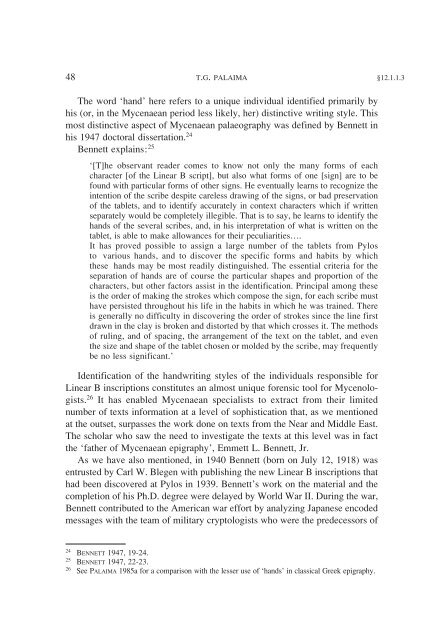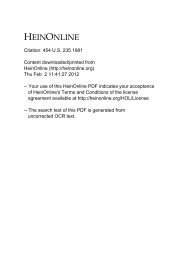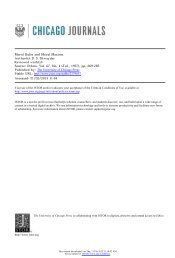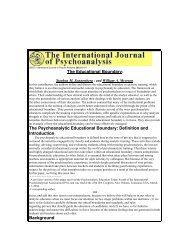A Companion to Linear B - The University of Texas at Austin
A Companion to Linear B - The University of Texas at Austin
A Companion to Linear B - The University of Texas at Austin
You also want an ePaper? Increase the reach of your titles
YUMPU automatically turns print PDFs into web optimized ePapers that Google loves.
48 T.G. PALAIMA §12.1.1.3<br />
<strong>The</strong> word ‘hand’ here refers <strong>to</strong> a unique individual identified primarily by<br />
his (or, in the Mycenaean period less likely, her) distinctive writing style. This<br />
most distinctive aspect <strong>of</strong> Mycenaean palaeography was defined by Bennett in<br />
his 1947 doc<strong>to</strong>ral dissert<strong>at</strong>ion. 24<br />
Bennett explains: 25<br />
‘[T]he observant reader comes <strong>to</strong> know not only the many forms <strong>of</strong> each<br />
character [<strong>of</strong> the <strong>Linear</strong> B script], but also wh<strong>at</strong> forms <strong>of</strong> one [sign] are <strong>to</strong> be<br />
found with particular forms <strong>of</strong> other signs. He eventually learns <strong>to</strong> recognize the<br />
intention <strong>of</strong> the scribe despite careless drawing <strong>of</strong> the signs, or bad preserv<strong>at</strong>ion<br />
<strong>of</strong> the tablets, and <strong>to</strong> identify accur<strong>at</strong>ely in context characters which if written<br />
separ<strong>at</strong>ely would be completely illegible. Th<strong>at</strong> is <strong>to</strong> say, he learns <strong>to</strong> identify the<br />
hands <strong>of</strong> the several scribes, and, in his interpret<strong>at</strong>ion <strong>of</strong> wh<strong>at</strong> is written on the<br />
tablet, is able <strong>to</strong> make allowances for their peculiarities….<br />
It has proved possible <strong>to</strong> assign a large number <strong>of</strong> the tablets from Pylos<br />
<strong>to</strong> various hands, and <strong>to</strong> discover the specific forms and habits by which<br />
these hands may be most readily distinguished. <strong>The</strong> essential criteria for the<br />
separ<strong>at</strong>ion <strong>of</strong> hands are <strong>of</strong> course the particular shapes and proportion <strong>of</strong> the<br />
characters, but other fac<strong>to</strong>rs assist in the identific<strong>at</strong>ion. Principal among these<br />
is the order <strong>of</strong> making the strokes which compose the sign, for each scribe must<br />
have persisted throughout his life in the habits in which he was trained. <strong>The</strong>re<br />
is generally no difficulty in discovering the order <strong>of</strong> strokes since the line first<br />
drawn in the clay is broken and dis<strong>to</strong>rted by th<strong>at</strong> which crosses it. <strong>The</strong> methods<br />
<strong>of</strong> ruling, and <strong>of</strong> spacing, the arrangement <strong>of</strong> the text on the tablet, and even<br />
the size and shape <strong>of</strong> the tablet chosen or molded by the scribe, may frequently<br />
be no less significant.’<br />
Identific<strong>at</strong>ion <strong>of</strong> the handwriting styles <strong>of</strong> the individuals responsible for<br />
<strong>Linear</strong> B inscriptions constitutes an almost unique forensic <strong>to</strong>ol for Mycenologists.<br />
26 It has enabled Mycenaean specialists <strong>to</strong> extract from their limited<br />
number <strong>of</strong> texts inform<strong>at</strong>ion <strong>at</strong> a level <strong>of</strong> sophistic<strong>at</strong>ion th<strong>at</strong>, as we mentioned<br />
<strong>at</strong> the outset, surpasses the work done on texts from the Near and Middle East.<br />
<strong>The</strong> scholar who saw the need <strong>to</strong> investig<strong>at</strong>e the texts <strong>at</strong> this level was in fact<br />
the ‘f<strong>at</strong>her <strong>of</strong> Mycenaean epigraphy’, Emmett L. Bennett, Jr.<br />
As we have also mentioned, in 1940 Bennett (born on July 12, 1918) was<br />
entrusted by Carl W. Blegen with publishing the new <strong>Linear</strong> B inscriptions th<strong>at</strong><br />
had been discovered <strong>at</strong> Pylos in 1939. Bennett’s work on the m<strong>at</strong>erial and the<br />
completion <strong>of</strong> his Ph.D. degree were delayed by World War II. During the war,<br />
Bennett contributed <strong>to</strong> the American war effort by analyzing Japanese encoded<br />
messages with the team <strong>of</strong> military cryp<strong>to</strong>logists who were the predecessors <strong>of</strong><br />
24 BENNETT 1947, 19-24.<br />
25 BENNETT 1947, 22-23.<br />
26 See PALAIMA 1985a for a comparison with the lesser use <strong>of</strong> ‘hands’ in classical Greek epigraphy.

















